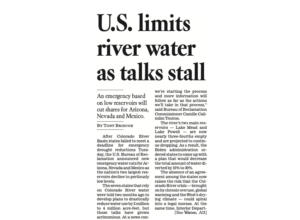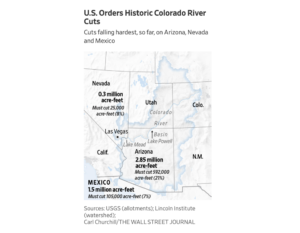Agriculture Secretary Brooke Rollins said on Tuesday that the Trump administration will announce a 'bridge payment' for farmers next week that is designed to provide short-term relief while longer trade…
Emergency Water Cuts Announced for Colorado River Basin States, Farmers Impacted
Tony Briscoe reported on the front page of Wednesday’s Los Angeles Times that, “After Colorado River Basin states failed to meet a deadline for emergency drought reductions Tuesday, the U.S. Bureau of Reclamation announced new emergency water cuts for Arizona, Nevada and Mexico as the nation’s two largest reservoirs decline to perilously low levels.
“The seven states that rely on Colorado River water were told two months ago to develop plans to drastically reduce water use by 2 million to 4 million acre-feet, but those talks have grown acrimonious. At a news conference Tuesday, federal officials said that an agreement was urgently needed and that it was declaring a Tier 2 shortage for next year — a historic first for the shrinking river.
“‘In order to avoid a catastrophic collapse of the Colorado River System and a future of uncertainty and conflict, water use in the basin must be reduced,’ said Tanya Trujillo, the Interior Department’s assistant secretary for water and science.”

The LA Times article explained that, “Under Tier 2 shortage conditions, Arizona’s annual water apportionment will be reduced by 21%, Nevada’s by 8% and Mexico’s by 7%. There is no required water savings contribution for California.”
Briscoe pointed out that, “The ominous reservoir projections and multistate water impasse have underscored the importance of investments in drought resilience and water management. Tuesday, President Biden signed the sweeping Inflation Reduction Act, which includes $4 billion in funding for water management and conservation efforts in the Colorado River Basin and other areas experiencing similar drought conditions.
“Much of that money is expected to be used to pay farmers and others to voluntarily use less water. Under one proposal offered by Arizona farmers, participating growers would forgo 1 acre-foot of water for each acre of farmland, generating roughly 925,000 acre-feet of savings.”

Washington Post writers Joshua Partlow and Karin Brulliard reported on the front page of Wednesday’s paper that, “Water managers and others expect farmers in the West will be paid to not plant crops. Many are hopeful that some of the funding could come from the $4 billion targeted for drought mitigation that’s part of the Inflation Reduction Act that President Biden signed Tuesday.”

Jim Carlton reported in Wednesday’s Wall Street Journal that, “A tension point has been the amount of water used by farmers, whose fields soak up as much as 80% of the Colorado’s water used by people, rather than for environmental purposes.
Reducing such allocations could raise food prices, according to agriculture officials.
And Henry Fountain reported on the front page of Wednesday’s New York Times that, “In Arizona, the cuts so far have largely affected farmers in the central part of the state, who have had to fallow fields or shift to less water-intensive crops to get by. Some farmers have left the business entirely.
“When it comes to the sharp reductions called for by [Camille Camlimlim Touton, commissioner of the Bureau of Reclamation, the federal agency with the authority to impose cuts], farmers are expected to be most affected as well. Agriculture uses about three-quarters of the Colorado supply.”
“During the discussions over the cuts, some agricultural groups floated the idea of farmers being compensated for taking some of their land out of production to conserve water. There is money in the just-signed Inflation Reduction Act that potentially could be used for such a program,” the Times article said.
Also this week, Bloomberg writers Kim Chipman and Mark Chediak reported that, “Farmers in Arizona, who provide more than 90% of the US’s leafy greens each November through March, have already borne the brunt of prior cuts, along with those who make a living from the state’s $23.3 billion agriculture industry. Pinal County, between Phoenix and Tucson, is likely to be hit especially hard since the area known for cotton and livestock has already seen about half its farmland go idle due to prior water reductions.”





